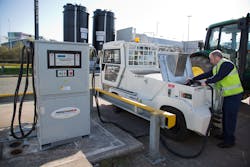Environmentally minded leaders around the world are constantly looking for ways to lower carbon dioxide (CO2) output and reduce their carbon footprint. In the aviation industry, ground handling operations have sought alternative energy ground support equipment (GSE) to help achieve these goals.
“The most significant benefits are the positive effect in terms of carbon footprint and sustainability, alongside huge cost savings and maintenance-free management of equipment,” Terri Smart-Jewkes, global sales and marketing director at Aviramp, says.
"By utilizing green GSE, you significantly reduce the environmental impact that fossil fuel has,” explains Alberto Rocha, sales director, Americas, ITW GSE.
“Electric vehicles also require less maintenance – there are fewer moving parts – and they last longer,” adds Lars Barsoe, VP of sales and marketing at Vestergaard Company. “Since there is no combustion engine, there is also no small particle pollution, which is a serious issue at airports.”
Less exposure to exhaust fumes, such as CO2 and nitrogen oxides (NOx), also benefits the health of ground handling personnel that perform aircraft turnarounds, notes Jerry Crump of PosiCharge.
Michael Nelson, general manager at Advanced Charging Technologies (ACT), points out maintenance costs can be lowered further with battery-powered GSE as no parts, oil, antifreeze, fuel filters and other components need to be replaced. What’s more, charging technology has greatly advanced.
“New generation chargers are more efficient and take less energy off the grid,” he adds.
By eliminating idling engines on the ramp, noise pollution can also be reduced. Alternative energy equipment can even contribute to cleaner environments in the areas immediately surrounding an airport.
“Less environmental impact is always the first benefit that comes to mind,” says Henry Balensifer, marketing and government relations manager at JBT LEKTRO. “The long term cost savings really is where the most significant benefits are, particularly now.”
Alternative Energy in Use
Alternative energy GSE is not new to the industry, necessarily. However, these technologies are regularly evolving and becoming increasingly efficient.
For example, Crump notes baggage tractors, belt-loaders, smaller pushback tractors and hydrant carts have utilized alternative energy, particularly electric battery power, for years.
“Today, we are seeing more of an influx in larger energy consuming GSE, such as pushback tractors and loaders, becoming more common as technology has improved in this segment,” he says.
According to Smart-Jewkes, solar power can also be effective in GSE, noting Aviramp developed an electric and solar suite of boarding ramps and bridges to help ground service providers meet pending sustainability mandates.
“We believe that electric and solar are gaining a great deal of traction and this would have progressed even further were it not for the COVID-19 global pandemic,” says Smart-Jewkes.
In addition to battery-powered equipment, Balensifer notes JBT LEKTRO has also worked with hydrogen fuel cells. But he points to a lack of infrastructure limiting the potential of that power source.
“We have hybrid equipment for areas where the charging stations are a mile or more away from the duty station, or for areas with limited power infrastructure,” Balensifer adds. “We have some other new technology in the works that enables airports to use existing infrastructure without putting any additional demand on the systems in place.”
According to Rocha, green GSE can be applied across numerous categories of equipment.
“Tractors, loaders, 400 Hz ground power units and pre-conditioned air can all utilize alternative energy technologies,” he says.
“Battery-powered GSE are more cost effective and scalable,” Nelson adds.
Companies like Vestergaard have also found alternative power solutions for equipment like lavatory and water units and deicers.
“This past year, we have launched fully electric chassis carrying toilet and water service vehicles, electric towable units and we have launched a hybrid/electric Elephant BETA deicer,” says Barsoe.
Industry Adoption
When it comes to alternative energy solutions, some equipment can come with higher upfront costs. But Nelson points out that can often be offset by lower operating and maintenance costs and examining the true cost of ownership.
Traditionally, a lack of electrical infrastructure to support implementation has slowed adoption of eGSE. However, Crump says this is beginning to change.
“The largest barrier is investing in infrastructure, and then losing that contract and not being able to deploy the chargers to where it best suits your operation,” he says. “Having the airports own the chargers helps to change this issue and add flexibility to the situation.”
“Electric infrastructure is a major challenge. Simply having enough power to make charging infrastructure possible is a huge challenge,” agrees Barsoe. “Another challenge is the time it takes to charge an electric vehicle compared to filling it with diesel or gasoline.”
He adds that having dialogue with the airports and power companies well before changing to electric units and planning sufficient space to charge and park vehicles can help alleviate these potential pain points.
“If they are utilizing certain assets that consume large amounts of energy to move from gate to gate, they may not be able to support flights,” Crump says. “PosiCharge assists the airports with the flexibility they need by offering multi-port charging solutions, which can charge up to 16 vehicles at once and share power with existing circuits and other devices at the jet bridge.”
Changing the behavior of ground handling personnel, especially when it comes to refueling/charging habits, is also a challenge, according to Rocha. However, with training and time, he says these challenges can be overcome.
“Habits can be hard to break and ground handlers are used to certain product types,” points out Smart-Jewkes, adding change management is imperative when an operation implements new technology.
Overcoming these challenges can be easy if the only change is the power source and if equipment can be operated similarly to previous models.
Continuous Advancements
Some ground handlers and service providers may be motivated to adopt green technology through grants.
Many airports are striving to achieve carbon accreditation, which could further incentivize switching to alternative powered equipment.
“Accreditations like these can act as incentives to help reduce emissions and create a much cleaner and sustainable environment,” Smart-Jewkes says. “Moreover, this is very much on the agenda on a macro level, globally. So, the incentive has been set universally that all industry must strive to be more sustainable and kinder to the environment.”
“There are regional incentive programs through state and local utilities to convert to alternative fuel GSE,” adds Nelson, noting his company works with local utilities to acquire any known incentives for customers.
Balensifer says that many U.S. states are allocating funds through the Diesel Emissions Reduction Act (DERA) or the Volkswagen emissions scandal settlement to incentivize removing diesels from airport ramps and deploying electric vehicles.
“California’s Air Resources Board and a few other states have also put together incentives for off-road emissions reduction programs that would incentivize the industry to use alternative GSE,” he adds.
With ongoing interest in alternative energy equipment continuing to grow, GSE manufacturers continue to invest in new solutions.
“All our conversations with clients are about sustainability,” Barsoe explains. “Vestergaard has long worked on solutions to reduce the environmental footprint, from reducing the amount of hot fluid needed in a deicing operation to increasing efficiencies in heating of fluids.
“And we have now taken that to new levels with our electric solutions,” he continues. “Vestergaard aims to provide a complete range of fossil-free ground support equipment by 2030.”
Similarly, ITW GSE’s research and development team has applied customer feedback to inspire new equipment designs. Rocha says these factors have helped the company develop its 400Hz and 28 VDC eGPUs.
“We also continue to invest in new sustainable technologies as we see the future on a battery-driven platform,” he says.
According to Balensifer, JBT LEKTRO is expending a large portion of its engineering efforts to improve the efficiency of the company’s electric options, in addition to making it easier for this eGSE to be used and maintained.
At ACT, the company has developed a line of UL outdoor rated, high efficiency battery chargers to charge electric GSE, utilizing lead acid as well as lithium-ion batteries
“ACT Quantum GSE Chargers are designed with Wi-Fi connectivity and can remotely implement energy management programs such as Peak Shaving, which reduces electrical usage during periods of maximum demand for the power utility, and Demand Response, which reduces electrical usage temporarily based on change in the price of power,” says Nelson.
ACT can also enroll customers, when applicable, to ACTenergy – a smart grid energy management platform, to reduce strain on the grid and reduce electrical consumption.
With changing technology, such as lithium-ion batteries becoming widely available and more cost effective, more markets for eGSE are opening up.
“By making Smart-Fast Chargers that allow for optimal fast charging rates, we have been able to lower the cost of battery maintenance and replacement for our customers, lowering the total cost of ownership for our customers,” Crump points out. “Our MVS system allows for internal power sharing amongst multiple charging ports to lower the demand for expensive infrastructure improvements.”
PosiCharge can also provide full CAN communication for lithium batteries and the ability to offer a telemetry system that allows customers to track charging events and energy usage.
“The benefits to the environment are self-explanatory. So, going green is the way forward and it is better for airports and handlers to be ahead of the curve as we believe it will be expected that the industry moves to more sustainable alternatives anyway,” says Smart-Jewkes. “And we think after the recent pandemic, there will be a moral obligation to try to achieve a much greener airport operation worldwide.
“The sooner airports recognize that fact, the sooner they can make headway to embrace greener alternatives and get ahead of the trend.”
About the Author
Josh Smith
Editor
Josh Smith served as editor of Ground Support Worldwide as editor from 2016 through 2024. He oversaw production of the print magazine, created GSW's newsletters on a daily basis, and updated the latest news on AviationPros.com.

